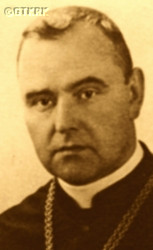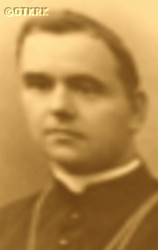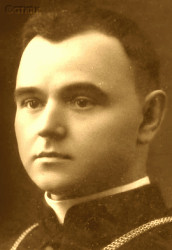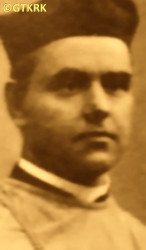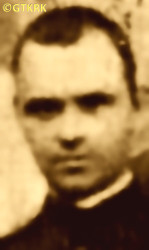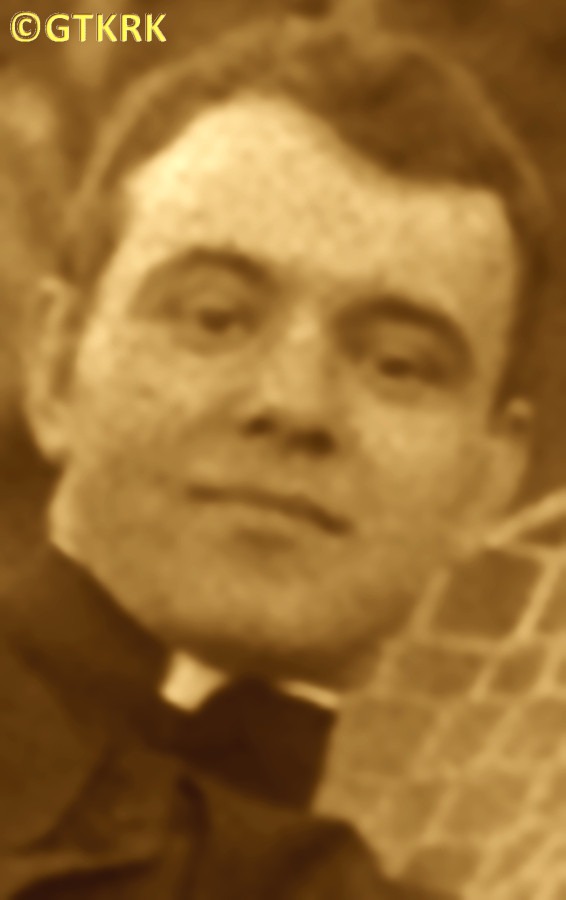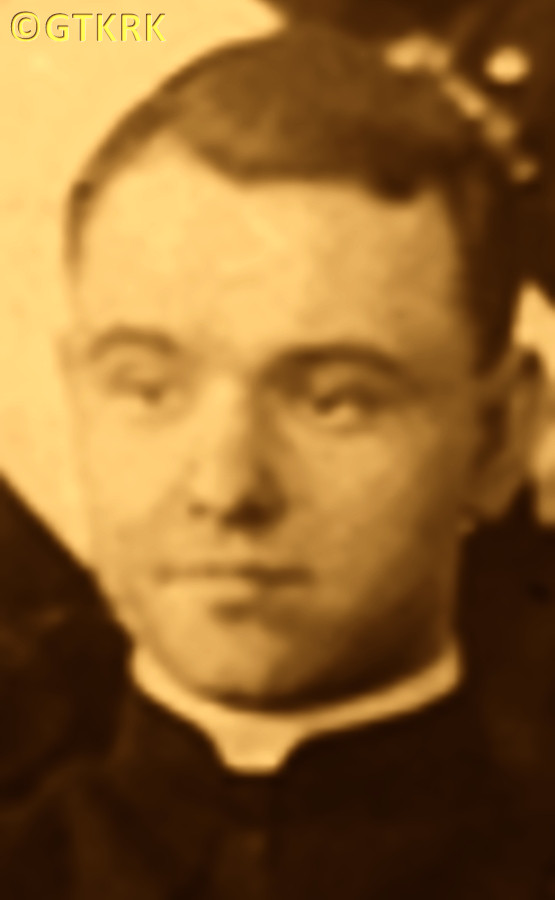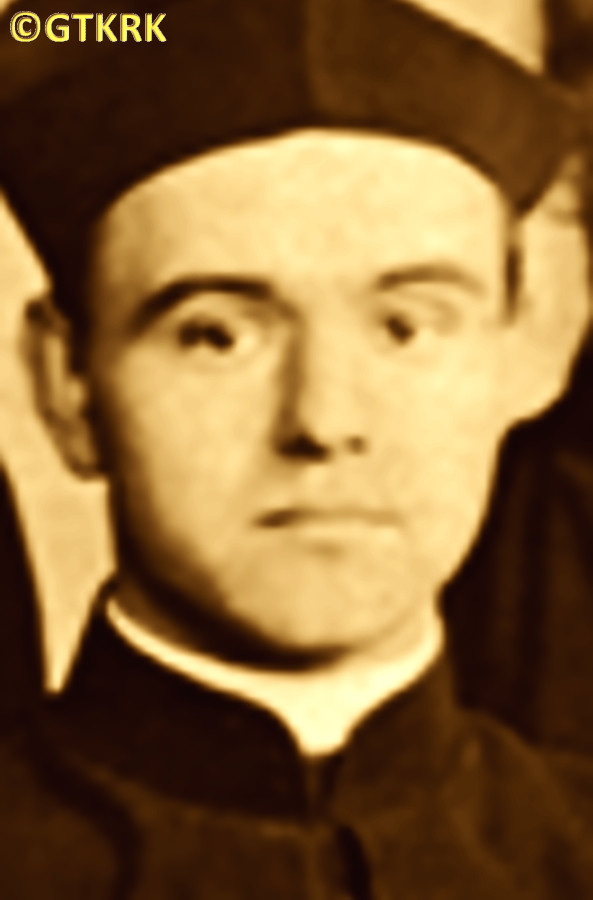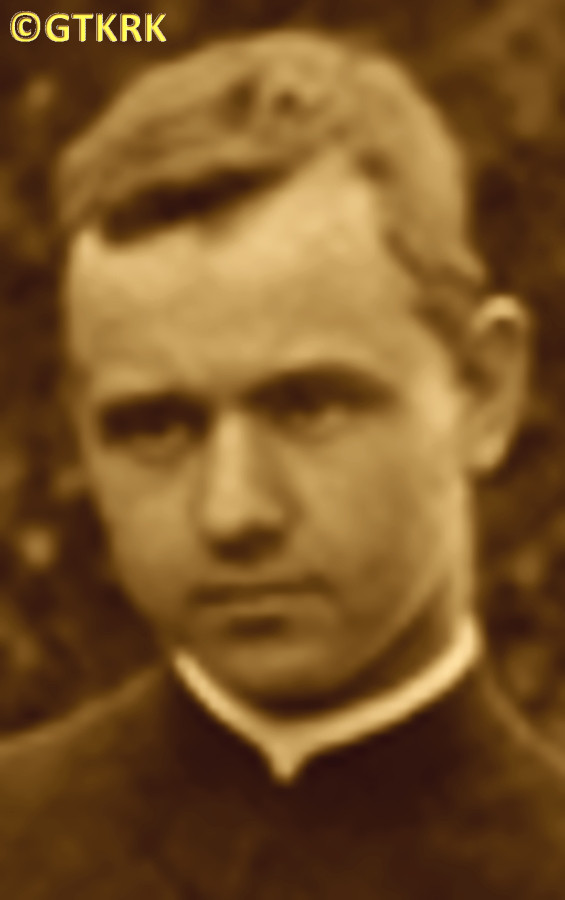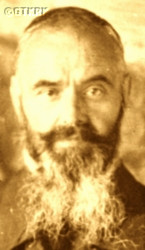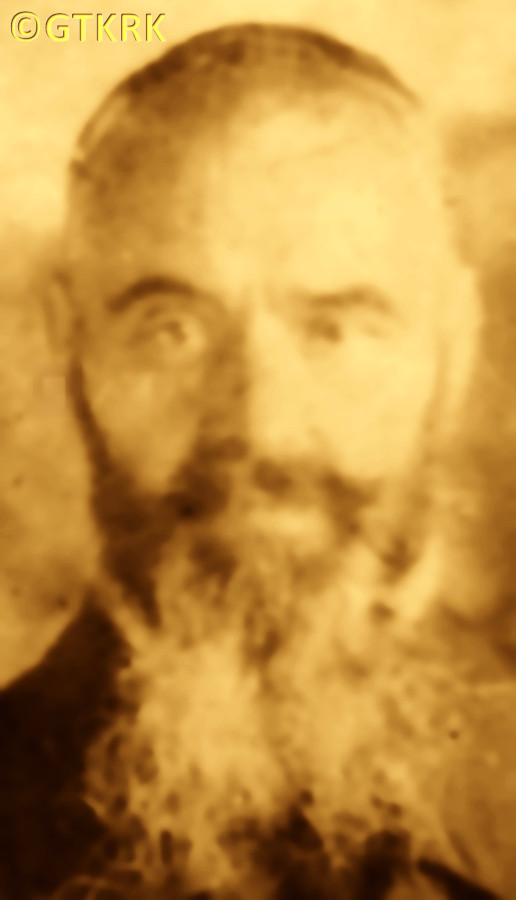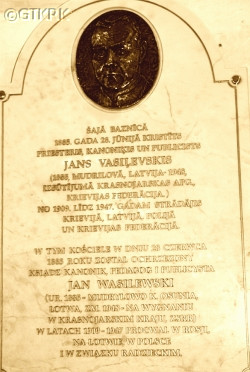Roman Catholic
St Sigismund parish
05-507 Słomczyn
85 Wiślana Str.
Konstancin deanery
Warsaw archdiocese, Poland
full list:
displayClick to display full list

searchClick to search full list by categories
wyświetlKliknij by wyświetlić pełną listę po polsku

szukajKliknij by przeszukać listę wg kategorii po polsku

Martyrology of the clergy — Poland
XX century (1914 – 1989)
personal data
surname
WASILEWSKI
forename(s)
John (pl. Jan)
function
diocesan priest
creed
Latin (Roman Catholic) Church RCmore on
en.wikipedia.org
[access: 2014.09.21]
diocese / province
Pinsk diocesemore on
en.wikipedia.org
[access: 2013.05.19]
Riga archdiocesemore on
en.wikipedia.org
[access: 2013.05.19]
Mogilev archdiocesemore on
en.wikipedia.org
[access: 2013.06.23]
academic distinctions
Sacred Theology Candidate
honorary titles
Minor Canonmore on
Minor Canon
(Assumption of the Blessed Virgin Mary RC cathedral church, Pinsktoday: Pinsk city dist., Brest reg., Belarus
more on
en.wikipedia.org
[access: 2022.07.16])
date and place
of death
09.03.1948

Kazachinskoyetoday: Kazachinskoye, Kazachinskoye reg., Krasnoyarsk Krai, Russia
more on
en.wikipedia.org
[access: 2022.08.05]
alt. dates and places
of death
10.03.1948
details of death
After Tsar resignation in 02.1917 and Bolshevik coup in 10.1917 in Russia publicly condemned Bolshevik terror few times.
For the first time arrested by Russians on 30.04‐01.05.1919 as a hostage, together with a group of Catholic priests — in response to the arrest of Bolsheviks by Poles in Vilnius, after the city was captured by the Polish Army on 18.04.1919, during the Polish–Russian War of 1919‐1921.
Held in genocidal CzeKa (predecessor of NKVD) prisons in Sankt Petersburg: at Grochowa Str. and next Szpalerna Str. Interrogated. Was supposed to have said: „The Catholic Church does not recognize and cannot recognize Bolshevik communism because it ignores man's spiritual development, which […] is an irrational thing; […] because it persecutes religion, spreads class hatred, abolishes the institution of marriage, considers children to be state property and forcibly deprives of private property those who have the right to it by nature”. Threaten with death.
Released on 20.06.1919 (or 22.07.1919).
In 1920 afraid of imminent arrest went into hiding for 5 months.
In 1921 took part in public debate, organized by soviet Russians — about existence of God.
Arrested again by the Russians on 02.05.1922 in Minsk — invited to a meeting with the Bolsheviks regarding the law sanctioning the robbery of church property, when arrived arrested on the spot — together with two other priests.
Held in GPU (successor to the Cheka) prison.
Accused of „concealing church valuables” and „communicating with representatives of the Polish authorities in Minsk”.
On 01.06.1922, in a group show trial, sentenced to 3 years in prison „with the use of forced labor”.
Incarcerated in a high‐security prison in Minsk.
From 18.07.1922 held in Butyrki prison in Moscow.
A year later, on 19.09.1923, released — exchanged by Latvian government for Russian spies in Latvia. Returned to Latvia.
In 1924 published a book „In the clutches of antichrist” about Bolshevik revolution in Russia.
In 1926 moved to Poland.
After German and Russian invasion of Poland in 09.1939 and start of the World War II, Pinsk was captured by the Russians, who robbed the Theological Seminary building and its resources (including the library), allocating it to the needs of the occupying army.
After German attack in 06.1941 of their erstwhile ally, Russians, evicted by the Germans from his flat — moved to an old dilapidated Jewish house.
Helped the Jews herded by the Germans into Pinsk ghetto.
Number of times interrogated by German Germ. Geheime Staatspolizei (Eng. Secret State Police), i.e. Gestapo.
After German defeat and start in 1944 of another Russian occupation, when in the autumn of 1944 Russians forbid conducting baptism and marriage ceremonies started to give them clandestinely, not recording them in the parish books.
Called in and interrogated many times by the genocidal Russian NKVD.
Encouraged to start clandestine cooperation with Russians, to deny thesis laid out in „In the clutches of antichrist”.
Refused and rejected those approaches.
Finally on 22.08.1945 arrested by the Russians.
Held in Minsk prison.
After two years of interrogations and tortures sentenced — at a trial to which no outsiders were allowed — on charges of „anti‐Russian and anti‐Soviet agitation”, to 10 years of „free exile”.
Perished in exile in Siberia, in Kazachinskoye village, the place of deportation of, among others, many Poles at the turn of the 19th and 20th centuries, where slaved in a local kovkhoz, i.e. collective farm.
cause of death
extermination
perpetrators
Russians
sites and events
Forced exileClick to display the description, GulagClick to display the description, MinskClick to display the description, Moscow (Butyrki)Click to display the description, Help to the JewsClick to display the description, Ribbentrop‐MolotovClick to display the description, Pius XI's encyclicalsClick to display the description
date and place
of birth
27.06.1885

Mudrilovātoday: Asūne pog., Krāslava mun., Latvia
parents
WASILEWSKI Alexander
🞲 1855, ? — 🕆 03.04.1944, ?

STANKIEWICZ Francesca
🞲 1863, ? — 🕆 14.03.1939, ?
baptism
28.06.1885

Asūnetoday: Asūne pog., Krāslava mun., Latvia
more on
en.wikipedia.org
[access: 2022.06.29]
Exaltation of the Holy Cross RC church
presbyter (holy orders)
ordination
25.03.1909

Sankt Petersburgtoday: Saint Petersburg city, Russia
more on
en.wikipedia.org
[access: 2020.07.31]
St John Cantius the Confessor RC chapelmore on
en.wikipedia.org
[access: 2020.11.13] (by Imperial RC Theological Academy)
positions held
1944 – 1945
vicar general — Pinsk RC diocese — part of the diocese occupied by the Russia
1939 – 1945
parish priest — Pinsktoday: Pinsk city dist., Brest reg., Belarus
more on
en.wikipedia.org
[access: 2022.07.16] ⋄ Assumption of the Blessed Virgin Mary RC cathedral parish ⋄ Pinsktoday: Pinsk city dist., Brest reg., Belarus
more on
en.wikipedia.org
[access: 2022.07.16] RC deanery
c. 1927 – 1939
Minor Canon — Pinsktoday: Pinsk city dist., Brest reg., Belarus
more on
en.wikipedia.org
[access: 2022.07.16] ⋄ Cathedral Chapter ⋄ Assumption of the Blessed Virgin Mary RC cathedral church — also: synodal examiner (1936‐1939), synodal judge at the Bishop's Court (1936‐1939), member of the „Consilium a Vigilantia” (Eng. Committee on Morals) (1936‐1939), diocesan censor of religious books (1936‐1939), deputy inspector of religious education of the Diocesan Curia (c. 1939), church assistant of the Diocesan Institute of Catholic Action (c. 1939)
from 1937
professor — Pinsktoday: Pinsk city dist., Brest reg., Belarus
more on
en.wikipedia.org
[access: 2022.07.16] ⋄ St Thomas Aquinas' Theological Seminary — lecturer in philosophy, history of philosophy and moral theology
1933 – 1937
rector — Drohiczyntoday: Drohiczyn gm., Siemiatycze pov., Podlaskie voiv., Poland
more on
en.wikipedia.org
[access: 2020.12.11] ⋄ St Stanislav Kostka the Confessor Lower Theological Seminary, i.e. diocesan Gymnasium for Men ⋄ Holy Trinity RC parish ⋄ Drohiczyntoday: Drohiczyn gm., Siemiatycze pov., Podlaskie voiv., Poland
more on
en.wikipedia.org
[access: 2020.12.11] RC deanery
1926 – 1933
rector — Pinsktoday: Pinsk city dist., Brest reg., Belarus
more on
en.wikipedia.org
[access: 2022.07.16] ⋄ St Thomas Aquinas' Theological Seminary — also: lecturer in moral theology and temporarily in liturgy and homiletics
1924 – 1926
vicar — Aglonatoday: Aglona pog., Preiļi mun., Latvia
more on
en.wikipedia.org
[access: 2022.06.29] ⋄ Assumption of the Blessed Virgin Mary RC parish
1924 – 1926
teacher — Aglonatoday: Aglona pog., Preiļi mun., Latvia
more on
en.wikipedia.org
[access: 2022.06.29] ⋄ Latin language, Catholic gymnasium — also: inspector
1923 – 1924
vicar — Alswagentoday: Alsunga, Alsunga pog., Kuldiga mun., Latvia
more on
en.wikipedia.org
[access: 2022.06.29] ⋄ St Michael the Archangel RC parish
28.03.1922 – 02.05.1922
priest — Minsktoday: Minsk city reg., Belarus
more on
en.wikipedia.org
[access: 2020.07.31] ⋄ RC chapel (in Calvary cemetery)
1917 – 1922
vicar — Sankt Petersburgtoday: Saint Petersburg city, Russia
more on
en.wikipedia.org
[access: 2020.07.31] ⋄ St Catherine of Alexandria the Virgin and Martyr RC parish ⋄ Sankt Petersburgtoday: Saint Petersburg city, Russia
more on
en.wikipedia.org
[access: 2020.07.31] RC deanery — also: lecturer at a clandestine theological seminary (temporarily), prefect in i.a. private homes, at private theological courses for intelligentsia, acting dean (during the hiding of the dean, Fr Constantine Budkiewicz)
1920
priest — Arkhangelsktoday: Primorsky reg., Arkhangelsk oblast, Russia
more on
en.wikipedia.org
[access: 2022.08.05] ⋄ St Peter and St Paul the Apostles RC parish — acting („ad interim”)
1910 – 1918
prefect — Sankt Petersburgtoday: Saint Petersburg city, Russia
more on
en.wikipedia.org
[access: 2020.07.31] ⋄ St Catherine of Alexandria the Virgin and Martyr RC parish ⋄ Sankt Petersburgtoday: Saint Petersburg city, Russia
more on
en.wikipedia.org
[access: 2020.07.31] RC deanery — including: 1912‐1918 prefect and Latin teacher at the Polish Gymnasium for boys by the St Catherine church; 1910‐1912 director and prefect at the Abp Staniskav John Bogush Siestrzeńcewicz pro‐gymnasium by St Stanislav church; prefect and tutor, i.a. in the 5th, 6th, 9th, 11th Gymnasium, the Pedagogical Institute, the Institute of the Duke of Oldenburg, the Naval Cadet Corps and the 1st Cadet Corps, the Pavlovsk Military School; temporarily acting („ad interim”) dean
1909 – 1910
lecturer — Sankt Petersburgtoday: Saint Petersburg city, Russia
more on
en.wikipedia.org
[access: 2020.07.31] ⋄ biblical archeology, Metropolitan Theological Seminary — also: prefect
1909
priest — Dzvinsktoday: Daugavpils, Daugavpils urban mun., Latvia
more on
en.wikipedia.org
[access: 2020.07.31] ⋄ Immaculate Conception of the Blessed Virgin Mary RC parish
c. 1909
vicar — Mogilevtoday: Mogilev dist., Mogilev reg., Belarus
more on
en.wikipedia.org
[access: 2022.01.06] ⋄ St Casimir RC parish ⋄ Mohylew / Horkideanery names/seats
today: Mogilev reg., Belarus RC deanery
c. 1908 – c. 1909
student — Louvaintoday: Flemish Brabant prov., Flemish reg., Belgium
more on
en.wikipedia.org
[access: 2020.11.07] ⋄ philosophy, Université Catholique de Louvain (pl. Catholic University of Leuven) — short‐term postgraduate supplementary studies
1906 – c. 1908
student — Sankt Petersburgtoday: Saint Petersburg city, Russia
more on
en.wikipedia.org
[access: 2020.07.31] ⋄ Imperial Roman Catholic Spiritual Academy (1842‐1918) — postgraduate specialised studies crowned in 06.1909 with Sacred Theology Candidate's degree
till 1906
student — Sankt Petersburgtoday: Saint Petersburg city, Russia
more on
en.wikipedia.org
[access: 2020.07.31] ⋄ philosophy and theology, Metropolitan Theological Seminary — studies started after graduating from the 1st Cadet Corps — high school and officer school — in Sankt Petersburg
others related
in death
KASZUBSKIClick to display biography Victor, MARKUSZEWSKIClick to display biography Albin, RESZETYŁOClick to display biography Roman
sites and events
descriptions
Forced exile: One of the standard Russian forms of repression. The prisoners were usually taken to a small village in the middle of nowhere — somewhere in Siberia, in far north or far east — dropped out of the train carriage or a cart, left out without means of subsistence or place to live. (more on: en.wikipedia.orgClick to attempt to display webpage
[access: 2014.12.20])
Gulag: The acronym Gulag comes from the Rus. Главное управление исправительно‐трудовых лагерей и колоний (Eng. Main Board of Correctional Labor Camps). The network of Russian concentration camps for slave labor was formally established by the decision of the highest Russian authorities on 27.06.1929. Control was taken over by the OGPU, the predecessor of the genocidal NKVD (from 1934) and the MGB (from 1946). Individual gulags (camps) were often established in remote, sparsely populated areas, where industrial or transport facilities important for the Russian state were built. They were modeled on the first „great construction of communism”, the White Sea‐Baltic Canal (1931‐1932), and Naftali Frenkel, of Jewish origin, is considered the creator of the system of using forced slave labor within the Gulag. He went down in history as the author of the principle „We have to squeeze everything out of the prisoner in the first three months — then nothing is there for us”. He was to be the creator, according to Alexander Solzhenitsyn, of the so‐called „Boiler system”, i.e. the dependence of food rations on working out a certain percentage of the norm. The term ZEK — prisoner — i.e. Rus. заключенный‐каналоармец (Eng. canal soldier) — was coined in the ITL BelBaltLag managed by him, and was adopted to mean a prisoner in Russian slave labor camps. Up to 12 mln prisoners were held in Gulag camps at one time, i.e. c. 5% of Russia's population. In his book „The Gulag Archipelago”, Solzhenitsyn estimated that c. 60 mln people were killed in the Gulag until 1956. Formally dissolved on 20.01.1960. (more on: en.wikipedia.orgClick to attempt to display webpage
[access: 2024.04.08])
Minsk: Russian prison. In 1937 site of mass murders perpetrated by the Russians during a „Great Purge”. After Russian invasion of Poland in 09.1939 and start of the World War II place of incarceration of many Poles, In 06.1941, under attack by Germans, Russians murdered there a group of Polish prisoner kept in Central and co‐called American prisons in Mińsk. The rest were driven towards Chervyen in a „death march” (10,000‐20,000 prisoners perished), into Russia. (more on: pl.wikipedia.orgClick to attempt to display webpage
[access: 2013.08.17])
Moscow (Butyrki): Harsh transit and interrogation prison in Moscow — for political prisoners — where Russians held and murdered thousands of Poles. Founded prob. in XVII century. In XIX century many Polish insurgents (Polish uprisings of 1831 and 1863) were held there. During Communist regime a place of internment for political prisoners prior to a transfer to Russian slave labour complex Gulag. During the Great Purge c. 20,000 inmates were held there at any time (c. 170 in every cell). Thousands were murdered. (more on: en.wikipedia.orgClick to attempt to display webpage
[access: 2020.05.01])
Help to the Jews: During World War II on the Polish occupied territories Germans forbid to give any support to the Jews under penalty of death. Hundreds of Polish priests and religious helped the Jews despite this official sanction. Many of them were caught and murdered.
Ribbentrop‐Molotov: Genocidal Russian‐German alliance pact between Russian leader Joseph Stalin and German leader Adolf Hitler signed on 23.08.1939 in Moscow by respective foreign ministers, Mr. Vyacheslav Molotov for Russia and Joachim von Ribbentrop for Germany. The pact sanctioned and was the direct cause of joint Russian and German invasion of Poland and the outbreak of the World War II in 09.1939. In a political sense, the pact was an attempt to restore the status quo ante before 1914, with one exception, namely the „commercial” exchange of the so‐called „Kingdom of Poland”, which in 1914 was part of the Russian Empire, fore Eastern Galicia (today's western Ukraine), in 1914 belonging to the Austro‐Hungarian Empire. Galicia, including Lviv, was to be taken over by the Russians, the „Kingdom of Poland” — under the name of the General Governorate — Germany. The resultant „war was one of the greatest calamities and dramas of humanity in history, for two atheistic and anti‐Christian ideologies — national and international socialism — rejected God and His fifth Decalogue commandment: Thou shall not kill!” (Abp Stanislav Gądecki, 01.09.2019). The decisions taken — backed up by the betrayal of the formal allies of Poland, France and Germany, which on 12.09.1939, at a joint conference in Abbeville, decided not to provide aid to attacked Poland and not to take military action against Germany (a clear breach of treaty obligations with Poland) — were on 28.09.1939 slightly altered and made more precise when a treaty on „German‐Russian boundaries and friendship” was agreed by the same murderous signatories. One of its findings was establishment of spheres of influence in Central and Eastern Europe and in consequence IV partition of Poland. In one of its secret annexes agreed, that: „the Signatories will not tolerate on its respective territories any Polish propaganda that affects the territory of the other Side. On their respective territories they will suppress all such propaganda and inform each other of the measures taken to accomplish it”. The agreements resulted in a series of meeting between two genocidal organization representing both sides — German Gestapo and Russian NKVD when coordination of efforts to exterminate Polish intelligentsia and Polish leading classes (in Germany called «Intelligenzaktion», in Russia took the form of Katyń massacres) where discussed. Resulted in deaths of hundreds of thousands of Polish intelligentsia, including thousands of priests presented here, and tens of millions of ordinary people,. The results of this Russian‐German pact lasted till 1989 and are still in evidence even today. (more on: en.wikipedia.orgClick to attempt to display webpage
[access: 2015.09.30])
Pius XI's encyclicals: Facing the creation of two totalitarian systems in Europe, which seemed to compete with each other, though there were more similarities than contradictions between them, Pope Pius XI issued in 03.1937 (within 5 days) two encyclicals. In the „Mit brennender Sorge” (Eng. „With Burning Concern”) published on 14.03.1938, condemned the national socialism prevailing in Germany. The Pope wrote: „Whoever, following the old Germanic‐pre‐Christian beliefs, puts various impersonal fate in the place of a personal God, denies the wisdom of God and Providence […], whoever exalts earthly values: race or nation, or state, or state system, representatives of state power or other fundamental values of human society, […] and makes them the highest standard of all values, including religious ones, and idolizes them, this one […] is far from true faith in God and from a worldview corresponding to such faith”. On 19.03.1937, published „Divini Redemptoris” (Eng. „Divine Redeemer”), in which criticized Russian communism, dialectical materialism and the class struggle theory. The Pope wrote: „Communism deprives man of freedom, and therefore the spiritual basis of all life norms. It deprives the human person of all his dignity and any moral support with which he could resist the onslaught of blind passions […] This is the new gospel that Bolshevik and godless communism preaches as a message of salvation and redemption of humanity”… Pius XI demanded that the established human law be subjected to the natural law of God , recommended the implementation of the ideal of a Christian state and society, and called on Catholics to resist. Two years later, National Socialist Germany and Communist Russia came together and started World War II. (more on: www.vatican.vaClick to attempt to display webpage
[access: 2023.05.28], www.vatican.vaClick to attempt to display webpage
[access: 2023.05.28])
sources
personal:
www.polacyizydzi.plClick to attempt to display webpage
[access: 2013.02.15], www.katolicy.euClick to attempt to display webpage
[access: 2021.12.19], www.pinsk.plClick to attempt to display webpage
[access: 2018.09.02], echapolesia.plClick to attempt to display webpage
[access: 2013.08.10], www.polskipetersburg.plClick to attempt to display webpage
[access: 2020.11.13], ru.openlist.wikiClick to attempt to display webpage
[access: 2022.08.05], polesie.orgClick to attempt to display webpage
[access: 2018.09.02]
bibliographical:
„Lexicon of Polish clergy repressed in USSR in 1939‐1988”, Roman Dzwonkowski, SAC, ed. Science Society KUL, 2003, Lublin
„Fate of the Catholic clergy in USSR 1917‐1939. Martyrology”, Roman Dzwonkowski, SAC, ed. Science Society KUL, 2003, Lublin
„Pinsk Diocese in Poland Clergy and Church Register”, Pinsk diocese bishop, 1933‐1939, diocesan printing house
„Martyrdom of the Polish clergy 1939‐1956”, Bp Bohdan Bejze, Antoni Galiński (ed.) – collection, Łódź Archdiocesan Publishing House, Łódź 1992
original images:
latgalesdati.du.lvClick to attempt to display webpage
[access: 2018.09.02], www.acadlib.lu.lvClick to attempt to display webpage
[access: 2018.09.02], docplayer.plClick to attempt to display webpage
[access: 2018.09.02], ru.openlist.wikiClick to attempt to display webpage
[access: 2019.10.13], pbc.biaman.plClick to attempt to display webpage
[access: 2019.05.30], www.polskipetersburg.plClick to attempt to display webpage
[access: 2020.11.13], www.polskipetersburg.plClick to attempt to display webpage
[access: 2020.11.13], www.polskipetersburg.plClick to attempt to display webpage
[access: 2020.11.13], www.polskipetersburg.plClick to attempt to display webpage
[access: 2020.11.13], docplayer.plClick to attempt to display webpage
[access: 2018.09.02], www.polskipetersburg.plClick to attempt to display webpage
[access: 2020.11.13], polesie.orgClick to attempt to display webpage
[access: 2018.09.02], ipn.gov.plClick to attempt to display webpage
[access: 2019.02.02]
LETTER to CUSTODIAN/ADMINISTRATOR
If you have an Email client on your communicator/computer — such as Mozilla Thunderbird, Windows Mail or Microsoft Outlook, described at WikipediaPatrz:
en.wikipedia.org, among others — try the link below, please:
LETTER to CUSTODIAN/ADMINISTRATORClick and try to call your own Email client
If however you do not run such a client or the above link is not active please send an email to the Custodian/Administrator using your account — in your customary email/correspondence engine — at the following address:

giving the following as the subject:
MARTYROLOGY: WASILEWSKI John
To return to the biography press below:
 Click to return to biography
Click to return to biography








